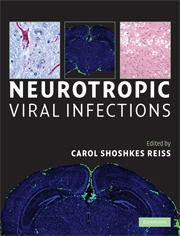Book contents
- Frontmatter
- Contents
- List of contributors
- Foreword
- Preface and acknowledgments
- Section I Introduction: RNA viruses
- 1 Neurotropic picornaviruses
- 2 Subacute sclerosing panencephalitis
- 3 Rabies
- 4 Neurotropic coronavirus infections
- 5 Arenavirus infection in the nervous system: uncovering principles of virus–host interaction and viral pathogenesis
- 6 Neurotropic alphaviruses
- 7 Flaviviruses
- Section II Introduction: retroviruses, DNA viruses, and prions
- Section III Introduction: immunity, diagnosis, vector, and beneficial uses of neurotropic viruses
- Index
- Plate section
- References
7 - Flaviviruses
from Section I - Introduction: RNA viruses
Published online by Cambridge University Press: 22 August 2009
- Frontmatter
- Contents
- List of contributors
- Foreword
- Preface and acknowledgments
- Section I Introduction: RNA viruses
- 1 Neurotropic picornaviruses
- 2 Subacute sclerosing panencephalitis
- 3 Rabies
- 4 Neurotropic coronavirus infections
- 5 Arenavirus infection in the nervous system: uncovering principles of virus–host interaction and viral pathogenesis
- 6 Neurotropic alphaviruses
- 7 Flaviviruses
- Section II Introduction: retroviruses, DNA viruses, and prions
- Section III Introduction: immunity, diagnosis, vector, and beneficial uses of neurotropic viruses
- Index
- Plate section
- References
Summary
Flaviviruses are small, positive-strand RNA viruses that are transmitted from infected to susceptible vertebrate hosts primarily by arthropods [1]. Flavivirus infections cause seasonal disease syndromes corresponding to mosquito and tick activity throughout the temperate and tropical areas of the world. These seasonal disease outbreaks have been recognized since the 1800s, although flaviviruses were not identified as the etiological agents and arthropods as the transmission vectors until early in the twentieth century, when virus isolation and characterization techniques were developed [1, 2, 3, 4]. The Flavivirus genus consists of nearly 80 viruses, approximately half of which are associated with human disease [1, 5]. Flaviviruses were originally classified in the Togaviridae family as group B arboviruses, to the group A arboviruses, now classified as alphaviruses (see Chapter 6), because they are both arthropod-borne viruses, or arboviruses, and they can cause similar disease syndromes. Both are also positive-strand RNA viruses; however, they have different genome organizations (see Chapter 6, and Figure 7.3) [5, 6]. The genus Flavivirus was later reclassified within the Flaviviridae family, which also includes the Pestivirus and Hepacivirus genera.
The majority of flaviviruses are arboviruses, with over half transmitted by mosquitoes and approximately one-third transmitted by ticks (Figure 7.1). Five flaviviruses have no known vector [1]. Flaviviruses are hypothesized to have derived from a monophyletic lineage, possibly a plant virus, which entered the transmission cycle of a common ancestor to both ticks and mosquitoes, or to ticks and then later mosquitoes [1, 7, 8].
- Type
- Chapter
- Information
- Neurotropic Viral Infections , pp. 120 - 138Publisher: Cambridge University PressPrint publication year: 2008



